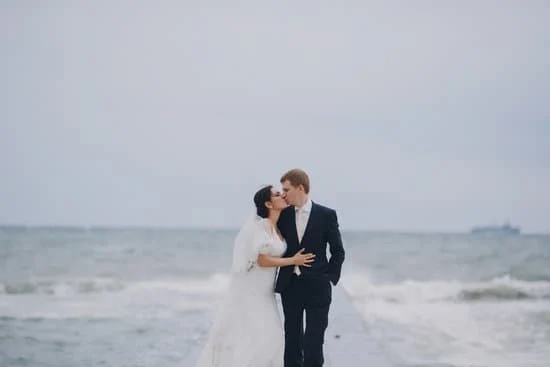The wedding march is a timeless and iconic piece of music that has been associated with weddings for over a century. It is a musical tradition that holds great significance in the celebration of marriage and has become a staple in wedding ceremonies around the world. But who wrote the wedding march? This article will delve into the history and significance of the wedding march, as well as explore the composer behind this beloved piece of music.
The use of the wedding march dates back to the mid-19th century, where it became popularized as a processional piece for brides entering their wedding ceremony. The solemn and majestic melody has since become synonymous with the joyous occasion, symbolizing love, commitment, and new beginnings. Its timeless appeal has made it a staple in traditional weddings, while also being incorporated into modern wedding ceremonies in various forms.
In this article, we will take a closer look at Felix Mendelssohn, the renowned composer who wrote the wedding march. We will explore his life and work to gain insight into the inspiration behind this beloved composition. Additionally, we will examine how Mendelssohn’s musical genius has left an enduring legacy on wedding traditions and popular culture. Join us as we uncover the story behind one of the most iconic pieces of music associated with weddings.
The Traditional Wedding March and Its Use in Modern Weddings
The traditional wedding march, commonly known as “Here Comes the Bride” or “Bridal Chorus,” has been a significant part of wedding ceremonies for centuries. This iconic piece of music has been played at countless weddings around the world and continues to hold a special place in the hearts of couples and their loved ones. The wedding march is typically used to accompany the bride’s entrance as she walks down the aisle, symbolizing her transition into marriage.
Evolution of the Traditional Wedding March
The origins of the traditional wedding march can be traced back to the 19th century when it was popularized by German composer Felix Mendelssohn. Over time, variations of this classic composition have emerged, with different cultures embracing their own unique versions of the wedding march. While some couples still opt for a traditional rendition of Mendelssohn’s piece, others choose to personalize their wedding march with alternative songs that hold special meaning to them.
Modern Usage of the Wedding March
In modern weddings, the traditional wedding march continues to be a staple element of the ceremony. However, many couples are exploring creative ways to incorporate this timeless piece into their nuptials, such as arranging contemporary interpretations or selecting instrumental renditions that reflect their personal style. Whether played by live musicians or streamed through speakers, the wedding march remains an integral part of the bridal procession and adds a sense of elegance and romance to the occasion.
Despite its enduring presence in weddings today, few people are aware that it was Felix Mendelssohn who wrote “Wedding March.” This classical masterpiece has become an essential component of marital ceremonies worldwide and embodies love and celebration in its purest form.
A Brief Biography of Felix Mendelssohn, the Composer of the Wedding March
Early Life and Musical Training
Felix Mendelssohn, born in Hamburg, Germany in 1809, was a child prodigy who showed an exceptional talent for music at a young age. He began studying piano with his mother when he was six and later received formal training from renowned music teachers. His family recognized his musical abilities early on and provided him with opportunities to develop his skills.
Compositional Style and Achievements
Mendelssohn’s compositions are known for their lyrical melodies, harmonic richness, and expressive use of orchestration. He was a versatile composer who wrote in various musical forms, including symphonies, concertos, chamber music, and choral works. His works display influences from classical composers such as Bach and Mozart while also incorporating elements of Romanticism.
Legacy and Influence
Mendelssohn’s contribution to the world of music extends beyond just the Wedding March. His compositions have left a lasting impact on classical music and continue to be performed and celebrated by musicians and audiences around the world. He was a prolific composer whose works encompassed both sacred and secular music, reflecting his deep respect for tradition while also embracing innovation in musical expression.
Mendelssohn’s legacy as one of the most important composers of the Romantic era is evident in his enduring musical contributions. The Wedding March serves as just one example of Mendelssohn’s ability to capture the essence of joyous occasions through his evocative compositions.
The Inspiration Behind Mendelssohn’s Composition
Felix Mendelssohn’s famous “Wedding March” is a well-known piece that has been used in weddings for decades. But what inspired the composer to write such a timeless and iconic piece of music? Let’s take a closer look at the inspiration behind Mendelssohn’s composition.
One source of inspiration for Mendelssohn’s “Wedding March” was actually William Shakespeare’s play, “A Midsummer Night’s Dream.” In 1826, Mendelssohn was just 17 years old when he first visited Britain, where he was asked to compose incidental music for a production of Shakespeare’s play. It was during this time that he wrote the well-known overture that would later become the “Wedding March”.
Another source of inspiration for Mendelssohn came from his own personal experiences. He composed the “Wedding March” as part of his suite of music for the play, which also included other pieces such as the overture and other intermezzos. This composition coincided with a joyful period in Mendelssohn’s life, as he had recently become engaged to be married himself.
Overall, it is clear that Mendelssohn drew inspiration from both literary and personal influences when writing the “Wedding March.” These different sources of inspiration combined to create a piece of music that would go on to become synonymous with weddings around the world.
The Wedding March and Its Impact on Wedding Traditions
The Wedding March composed by Felix Mendelssohn has had a significant impact on wedding traditions throughout the years. This iconic piece of music is often played during the processional and recessional at weddings, and its use has become a staple in modern wedding ceremonies. Here are some ways in which the Wedding March has influenced wedding traditions:
- The Processional: The Wedding March is commonly used as the processional music, marking the entrance of the bridal party and the bride herself. This tradition can be traced back to the royal wedding of Princess Victoria and Prince Frederick of Prussia in 1858, where Mendelssohn’s composition was first used for this purpose.
- The Recessional: Following the exchange of vows and rings, the newly married couple makes their way back down the aisle, usually accompanied by the joyful sounds of Mendelssohn’s Wedding March. This tradition symbolizes celebration and triumph, as it marks the beginning of a new chapter for the newlyweds.
- Symbolism and Tradition: The use of Mendelssohn’s Wedding March has become deeply ingrained in wedding culture, representing love, unity, and tradition. Many couples choose to incorporate this timeless piece into their ceremony as a way to pay homage to longstanding customs while also adding a touch of grandeur to their special day.
As we can see, Mendelssohn’s Wedding March has left an indelible mark on wedding traditions around the world, showcasing both its enduring popularity and longstanding significance within matrimonial celebrations. Its impact continues to resonate with couples who seek to honor tradition while celebrating their love for one another.
Other Notable Compositions by Felix Mendelssohn
Felix Mendelssohn was a prolific composer, with a wide range of musical compositions that have stood the test of time. In addition to the famous Wedding March, Mendelssohn wrote numerous other notable pieces that have become favorites in the classical music repertoire.
One such composition is his “Violin Concerto in E minor,” which is considered one of the most important violin concertos in the history of music. This concerto showcases Mendelssohn’s mastery of orchestration and his ability to create lyrical, emotional melodies.
Another one of Mendelssohn’s well-known compositions is his “Symphony No. 4,” also known as the “Italian Symphony.” This symphony is inspired by Mendelssohn’s travels through Italy and captures the spirit and vitality of Italian music and culture. The “Italian Symphony” has been praised for its vibrant and colorful orchestration, as well as its evocative melodies.
Mendelssohn also wrote a number of popular overtures, including “The Hebrides Overture” and “A Midsummer Night’s Dream Overture.” The latter is part of Mendelssohn’s score for Shakespeare’s play “A Midsummer Night’s Dream,” which includes not only the overture but also several incidental pieces for orchestra and chorus. This work showcases Mendelssohn’s gift for capturing the magical and fantastical elements of the play through his music.
| Composition | Description |
|---|---|
| Violin Concerto in E minor | One of the most important violin concertos in history |
| Symphony No. 4 (“Italian Symphony”) | Inspired by Mendelssohn’s travels through Italy, captures the spirit and vitality of Italian music |
| “The Hebrides Overture” and “A Midsummer Night’s Dream Overture” | Two popular overtures showcasing Mendelssohn’s diverse musical talents |
The Wedding March in Popular Culture
The Wedding March composed by Felix Mendelssohn has become an iconic piece of music often associated with weddings. It has transcended its original purpose and has been featured in various forms of popular culture, including movies, TV shows, and commercials. Its recognizable melody and joyful tone make it a fitting choice for any scene depicting a wedding or a celebration of love.
One of the most famous uses of Mendelssohn’s Wedding March in popular culture is in the 1935 film adaptation of William Shakespeare’s “A Midsummer Night’s Dream.” The use of the composition in this classic movie has cemented its association with weddings and romance in the public consciousness. Additionally, the Wedding March has been used in numerous other films, such as “The Graduate,” “Legally Blonde,” and “Shrek,” further solidifying its place in popular culture.
Moreover, the Wedding March can also be heard in various TV shows, from sitcoms to dramas, during scenes featuring weddings or romantic moments. Its widespread use across different forms of media showcases the enduring popularity and significance of Mendelssohn’s composition. In addition to its presence in visual media, the Wedding March is often utilized in advertising to convey themes of love, commitment, and new beginnings.
| Popular Culture References | Examples |
|---|---|
| Movies | “A Midsummer Night’s Dream,” “The Graduate,” “Legally Blonde,” “Shrek” |
| TV Shows | Variety of sitcoms and dramas |
| Commercials | Various advertisements centered around themes of love and commitment |
Conclusion
In conclusion, the Wedding March has had a significant impact on wedding traditions and continues to be an essential part of modern ceremonies. Its enduring legacy is a testament to the genius of composer Felix Mendelssohn, who wrote the wedding march in 1842 as part of his incidental music for Shakespeare’s play, “A Midsummer Night’s Dream”.
Mendelssohn’s composition has become synonymous with weddings, symbolizing love, joy, and celebration. Its use in modern weddings reaffirms its timeless appeal and enduring significance. The Wedding March has transcended generations and cultures, remaining a cherished tradition around the world.
Felix Mendelssohn’s musical genius goes beyond the Wedding March, with numerous other notable compositions that have left an indelible mark on classical music. His ability to capture emotion and evoke a sense of grandeur through his music cements his status as one of the greatest composers of the Romantic era.
The legacy of Mendelssohn’s musical contributions will continue to inspire generations to come, ensuring that the Wedding March remains an integral part of wedding ceremonies for years to come.
Frequently Asked Questions
Who Wrote the Traditional Wedding March?
The traditional wedding march was written by the famous German composer Felix Mendelssohn. It is one of the most iconic pieces of music played during wedding ceremonies around the world.
Is the Wedding March by Wagner or Mendelssohn?
The Wedding March commonly associated with weddings is actually composed by Felix Mendelssohn, not Richard Wagner. Although Wagner’s “Bridal Chorus” is also played at weddings, it is Mendelssohn’s composition that is often referred to as the Wedding March.
What Is the Story Behind Mendelssohn’s Wedding March?
The story behind Mendelssohn’s Wedding March dates back to 1842 when he composed it as part of his “A Midsummer Night’s Dream” incidental music. Originally intended for Shakespeare’s play, its soaring melody and joyful tone have made it a popular choice for wedding processions ever since.

Welcome to my blog about home and family. This blog is a place where I will share my thoughts, ideas, and experiences related to these important topics. I am a stay-at-home mom with two young children. I hope you enjoy reading it! and may find some helpful tips and ideas that will make your home and family life even better!





